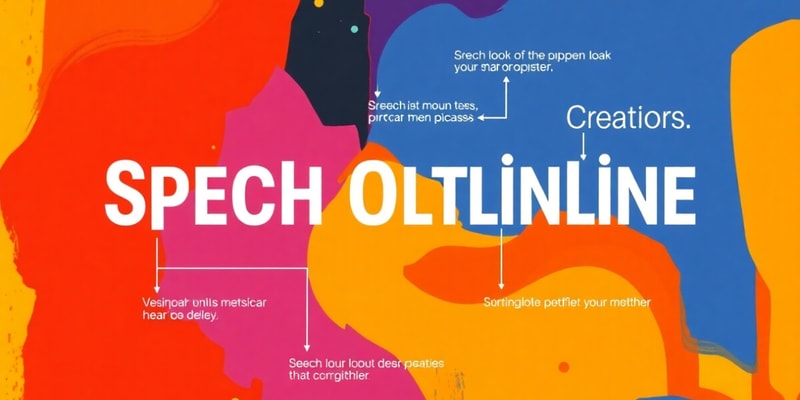Podcast
Questions and Answers
What is the purpose of creating an outline for a speech?
What is the purpose of creating an outline for a speech?
A Preparation Outline should always be handwritten.
A Preparation Outline should always be handwritten.
False
What are the primary symbols used in standard outlining?
What are the primary symbols used in standard outlining?
Roman numerals for main points and capital letters for primary subpoints.
The standard outlining form is required because it is ______, precise, and logical.
The standard outlining form is required because it is ______, precise, and logical.
Signup and view all the answers
If a point cannot be divided into at least two subpoints, what does it imply?
If a point cannot be divided into at least two subpoints, what does it imply?
Signup and view all the answers
Match the following outlining symbols with their corresponding use:
Match the following outlining symbols with their corresponding use:
Signup and view all the answers
What are transition points in a speech?
What are transition points in a speech?
Signup and view all the answers
What is the primary reason for including oral citations in a speech?
What is the primary reason for including oral citations in a speech?
Signup and view all the answers
It is acceptable to cover multiple issues at a time in a Preparation Outline.
It is acceptable to cover multiple issues at a time in a Preparation Outline.
Signup and view all the answers
Citing information that is common knowledge during a speech is necessary.
Citing information that is common knowledge during a speech is necessary.
Signup and view all the answers
What is the recommended number of citations for a 7-minute speech?
What is the recommended number of citations for a 7-minute speech?
Signup and view all the answers
A complete oral citation should include the source's name, ____ , publication found, and date of publication.
A complete oral citation should include the source's name, ____ , publication found, and date of publication.
Signup and view all the answers
Match the citation method with its description:
Match the citation method with its description:
Signup and view all the answers
Students must combine oral citations used in the speech with the Source Cited Page.
Students must combine oral citations used in the speech with the Source Cited Page.
Signup and view all the answers
What is the main purpose of a Presentation Outline?
What is the main purpose of a Presentation Outline?
Signup and view all the answers
Approximately ____ % of students do not cite sources properly in their presentations.
Approximately ____ % of students do not cite sources properly in their presentations.
Signup and view all the answers
What is a potential consequence of not citing sources properly?
What is a potential consequence of not citing sources properly?
Signup and view all the answers
Using poorly organized notecards can enhance overall credibility during a presentation.
Using poorly organized notecards can enhance overall credibility during a presentation.
Signup and view all the answers
Name one type of organizational strategy used in presentations.
Name one type of organizational strategy used in presentations.
Signup and view all the answers
Supporting materials include facts, definitions, _____, examples, and statistics.
Supporting materials include facts, definitions, _____, examples, and statistics.
Signup and view all the answers
Match the type of supporting material with its description:
Match the type of supporting material with its description:
Signup and view all the answers
Why should personal knowledge or stories be used in presentations?
Why should personal knowledge or stories be used in presentations?
Signup and view all the answers
Expert testimony is the least reliable form of supporting material.
Expert testimony is the least reliable form of supporting material.
Signup and view all the answers
What should speakers avoid when preparing their presentations to prevent organizational problems?
What should speakers avoid when preparing their presentations to prevent organizational problems?
Signup and view all the answers
Primary sources are the _____ of the information.
Primary sources are the _____ of the information.
Signup and view all the answers
Match the types of sources with their characteristics:
Match the types of sources with their characteristics:
Signup and view all the answers
What can well-chosen statistics provide in a presentation?
What can well-chosen statistics provide in a presentation?
Signup and view all the answers
Color coding notecards can help maintain organization during a presentation.
Color coding notecards can help maintain organization during a presentation.
Signup and view all the answers
What should speakers do if they find it difficult to read their own handwriting?
What should speakers do if they find it difficult to read their own handwriting?
Signup and view all the answers
Supporting materials should be accurate, current, and come from a _____ source.
Supporting materials should be accurate, current, and come from a _____ source.
Signup and view all the answers
Study Notes
Speech Outlining
- Preparation Outline (Full-Sentence Outline) is a detailed outline for a speech that requires full sentences and uses Roman numerals for main points, capital letters for primary subpoints, numbers for secondary subpoints, etc.
- Each point should be divided into at least two subpoints, otherwise, it's likely not substantial enough.
- Each primary subpoint can be further divided into secondary subpoints that flow from the primary subpoints.
- Writing in full sentences helps think in complete thoughts and assess the speech length.
Speech Transitions
- Transitions are connecting words or phrases that separate key points in a speech and help with delivery, organization, and audience memory retention.
- They are used at the end of the introduction (repeating the thesis statement), between main points/arguments, and leading into the conclusion.
Presentation Outline
- Presentation Outline (Delivery Outline) is a condensed version of the Preparation Outline used for notecards during presentation delivery.
- Notecards should be brief to aid memory and help with keeping track of the speech.
- Do not wait until the last minute to prepare notecards, start practicing with the outline early on.
Organizational Patterns
- Organizational Patterns help structure speeches, including Chronological, Spatial, Causal, and Comparative.
- Most common organizational problems include time misallocation for each section, spending too much time on one aspect than others, and lack of proper organizational pattern.
Supporting Materials
- Supporting Materials can include facts, definitions, testimony, examples, statistics, and personal knowledge.
- Facts are verifiable information about people, events, places, dates, etc. For example, “the Golden Gate Bridge opened to traffic on May 28, 1937.”
- Definitions are brief explanations used to inform the audience about something unfamiliar. For example, “Digital piracy refers to the illegal trade of software, videos, DVDs, and music.”
- Testimony is support material using firsthand knowledge or opinions of someone else. Expert Testimony is the most reliable form.
- Examples are specific instances/cases that illustrate points in a presentation. They should be relevant and brief.
- Statistics are numerical facts that summarize, organize, and tabulate information. They can support claims, show trends, correct false assumptions, validate hypotheses, and contradict myths.
- Use personal experiences/knowledge sparingly, only when relevant and with brevity.
- Primary Sources are the original source of information (i.e., autobiography) while Secondary Sources cite, review, or build upon other sources.
- Scholarly Sources are written for academic or professional readers, while Popular Sources are written for general readers.
Citing Sources
- Citation of information sources enhances speaker credibility and persuasiveness.
- A good rule of thumb is to cite approximately 7 times in a 7-minute speech.
- Oral citations are different from the Source Cited Page attached to the full sentence outline.
- Cite information that is not common knowledge.
Example Oral Citations:
- “…According Unite States Surgeon General Jerome Adams, approximately 50,000 Americans die from the flu every year.”
- “…General Motors recently recalled all its Silverado and Sierra trucks built in 2018 due to an engine block issue, stated Andy Dufraime, editor of Road and Track Magazine.”
Using Supporting Materials
- Directly: the easiest and most common approach.
- Comparison: pointing out similarities between two or more ideas.
- Analogies: explaining the unfamiliar by comparing it to the familiar.
- Quoting Directly: verbatim repetition.
- Paraphrasing: restating the content in own words.
Importance of Source Citation
- It helps organize the speech for the audience, clarifies confusion/ambiguity, and prevents plagiarism.
- Lack of proper citation can negatively affect presentation grades.
- Vary cited sources to avoid the audience assuming all information is from one source.
- APA Formatting is required for the Source Cited Page.
- Approximately 50% of students do not cite sources properly.
Note:
- The text above is a guide for preparing and delivering speeches.
- It emphasizes the importance of proper outlining, transitions, organizational patterns, supporting materials, and source citation.
- It aims to equip students with the necessary tools to create effective and engaging presentations.
Studying That Suits You
Use AI to generate personalized quizzes and flashcards to suit your learning preferences.
Description
Test your knowledge on the principles of speech outlining and transitions. This quiz covers crucial aspects of creating both preparation and presentation outlines, including the significance of using full sentences and effective transitions to enhance the delivery of a speech.




